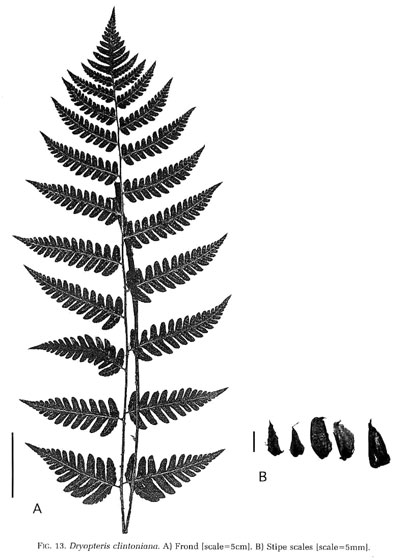| Dryopteris clintoniana | ||
Clinton's wood fern | ||
|
Etymology
Named for Judge G.W. Clinton (1807-1885), a well known naturalist of Buffalo, New York.
Description
Rhizome: short-creeping.
Frond: 120 cm high by 20 cm wide, fertile fronds deciduous, sterile evergreen, somewhat dimorphic, fertile (1-several) smaller, blade/stipe ratio: 2:1 to 3:1. Stipe: grooved, green, dark brown at base, scales scattered, tan, vascular bundles: 5 in a c-shaped pattern. Blade: 1-pinnate-pinnatifid, almost more, lanceolate with nearly parallel sides, tapering only in the upper �, herbaceous, linear to ovate scales below, absent above. Pinnae: 14 to 16 pair, above the basal pair, more alternate than opposite; costae grooved above, continuous from rachis to costae; margins serrate, minutely spiny; veins free, forked. Sori: round, on veins, closer to the costa than the margin, indusium: reniform, at a sinus, sporangia: brownish, maturity: midsummer. Culture
Habitat: swampy woods.
Distribution: ne North America.
Hardy to -35�C, USDA Zone 3.
Synonyms
Dryopteris cristata (L.) Gray var. clintoniana (D.C. Eat.) Underwood Dryopteris poyseri Wherry Aspidium cristatum (L.) Swartz var. clintonianum D. C. Eaton Thelypteris clintoniana House Dryopteris claytoniana, invalid |
|
|

Dryopteris clintoniana. Five vascular bundles at both the base and the top of the stipe. �Drawing from Ferns of Northeastern United States, Farida A. Wiley, 1936. |

Dryopteris clintoniana. a) frond, to 80 cm, long and broad (20 cm) but often great variation on the same plant; b) fertile pinnules, not quite 2-pinnate. �Illustration by V. Fulford from Ferns and Fern Allies of Canada, William J. Cody and Donald M. Britton, 1989, � Agriculture Canada, used with permission. |
